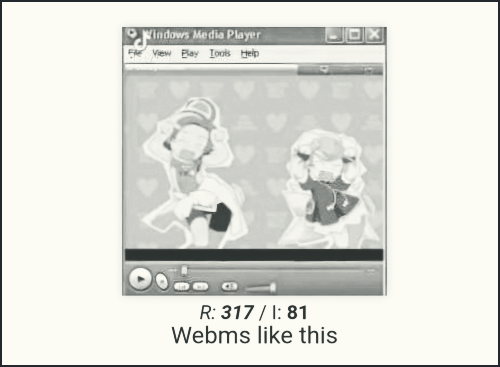A very short parable on animecore

2020- The rapid diffusion of the SARS-CoV-2 pandemic worldwide spurs countries to impose a cordon sanitaire. Many institutions are closed off allowing for half of the world's population to be in lockdown. Screen time is on the rise. 2009- YouTube sets to implement a recommendation algorithm that personalizes each viewer's home page, in lieu of the universal manual curating that was used prior. ????- soft moe buzz rebounds off of the bunker's gilded walls. terebi nico terror. the resistance leader lies low, waiting for the chance to reclaim Big Sight once more. 2007- The first episode of Lucky Star airs on Chiba TV.
It is critical to appreciate zoomers' interfacing with the Internet if we wish to understand what animecore really is, and what led to its genesis. On a historical level, more than half of USian households were estimated to own home computers in 2003. The simultaneous democratization of broadband connection made the access to the World Wide Web faster, livelier and "hyper". Zoomers had to be the first ever generation cradled without the sharp whirrs of dial-up network, and by their adolescence, computers had already become wireless and tactile. Decades worth of audiovisual entertainment, and the oppressive totality of the past lied readily available clear of hitting LMB. Your parasympathetic system gets assailed by the urgencies of communication technology. The public relay chats, usenet services, and even search engines, which seemed so central to navigating the Internet's waters had been replaced with rows of algorithmic content made for you and by your feedback. Yet, your eyes face not the horizon. The emergence of this paradigm proved more to suspend the machine of culture than hasten it.
The wealth of anime, visual novels and otaku-adjacent media online starts to be restructured under these conditions. And because these communication websites that have monopoly over culture serve many, it follows that the different processes that govern them eventually come to reproduce a similar division of content. Pinterest deterritorializes user fed images and reterritorializes them into digestible pieces of an aesthetic with the utmost crudeness and caprice. One crucial internal logic of this system is the drive to classify things into "cores" whereby it takes to the signs as opposed to the things signified, the substances of which are more than what they look to be. Zoomers have nothing left to classify, for the algorithm has done it for them. In this oculocentric approach relations of affect known only to man (passions of the mind ; animi pathema) are compressed with mechanic precision—moé becomes not the warm sprouting feeling that a character stimulates in the viewer, but the character itself. As the concept of culture as temporality withers away, it all melts into one indistinguishable mass to the untrained eye.

